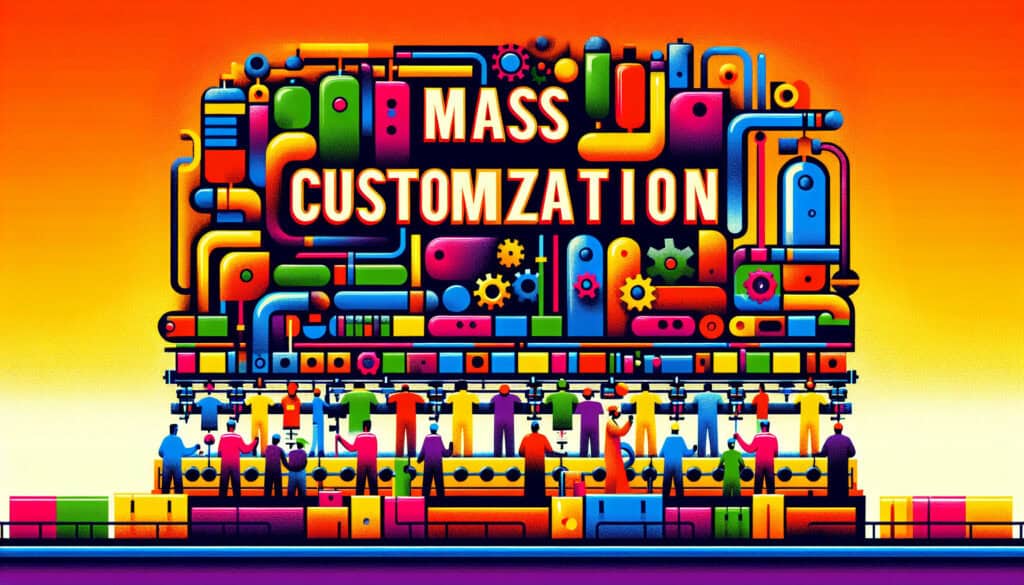To produce customized products on a large scale.
- المنهجيات: لين سيجما, تصنيع
التخصيص الشامل

التخصيص الشامل
- المنهجية الرشيقة, تجربة العملاء, التصنيع اللين, تصنيع, تصميم المنتج, تطوير المنتجات
الهدف:
كيفية استخدامه:
- A manufacturing and marketing strategy that combines the flexibility of custom-made products with the low unit costs of mass production. This is often achieved through modular product design and flexible manufacturing systems.
الايجابيات
- Allows for a high degree of customization at a low cost; Can increase customer satisfaction and market share.
سلبيات
- Can be complex to manage and may require significant investment in technology; Can lead to longer lead times.
الفئات:
- العملاء والتسويق, تصنيع
الأفضل لـ
- Producing customized products, such as computers, cars, or shoes, on a large scale.
Mass Customization has found its applications across various industries, including consumer electronics, automotive, and footwear, where companies aim to meet specific customer preferences while maintaining cost efficiency. Within the project phase of product development, this methodology is particularly suited to the design and prototyping stages, where iterative feedback loops can rapidly adapt modular components to meet diverse client needs through advanced manufacturing technologies such as 3D printing and CNC machining. Engaging cross-functional teams from engineering, marketing, and design ensures that all aspects of customization are addressed, allowing for a seamless integration of consumer input into the product development process. Initiatives often stem from market research that identifies customer demands for personalized experiences, leading to strategies that enhance brand loyalty and increase profit margins. For instance, automotive firms like BMW and Tesla utilize this approach to offer consumers the ability to configure their vehicles with various features, colors, and technologies while still benefiting from the efficiencies of mass production techniques. Furthermore, companies implementing Mass Customization invest in flexible manufacturing systems that can accommodate varying production volumes and configurations, further driving down costs while increasing responsiveness to changing market trends. This dynamic strategy not only satisfies individual consumer desires but also encourages a stronger emotional connection between the brand and its clients, ultimately contributing to sustained competitive advantage.
الخطوات الرئيسية لهذه المنهجية
- Identify customer segments and their specific customization needs.
- Design a modular product architecture that allows for variations without significant changes to production processes.
- Develop a flexible manufacturing system that can adapt to different product configurations efficiently.
- Implement advanced information systems to manage and track customer orders and preferences in real-time.
- Integrate supply chain partners to ensure timely availability of customizable components.
- Establish a pricing strategy that reflects the cost of customization while remaining competitive.
- Launch marketing campaigns that highlight the customization options and the value proposition to target segments.
- Gather post-purchase feedback to continuously refine the customization options and improve the product offering.
نصائح للمحترفين
- Incorporate advanced data analytics to monitor customer preferences and adapt offerings in real-time, enhancing responsiveness to market trends.
- Implement a robust supply chain management system that supports dynamic inventory management to facilitate a seamless flow of customized components.
- Utilize generative design algorithms during the product development phase to explore a wider range of modular configurations efficiently tailored to customer needs.
لقراءة عدة منهجيات ومقارنتها, نوصي باستخدام
> مستودع المنهجيات الشامل <
مع أكثر من 400 منهجية أخرى.
نرحب بتعليقاتكم على هذه المنهجية أو المعلومات الإضافية على قسم التعليقات أدناه ↓، وكذلك أي أفكار أو روابط متعلقة بالهندسة.
منشورات ذات صلة
حاسبة METS إلى السعرات الحرارية
التحليل التلوي
تخطيط الرسائل
مخططات النموذج الذهني
الحد الأقصى لقوى الدفع والسحب المقبولة
تخطيط الاحتياجات المادية (MRP)